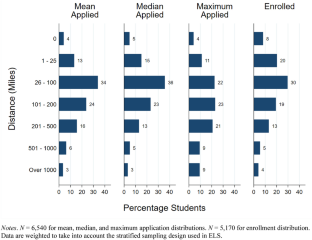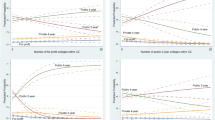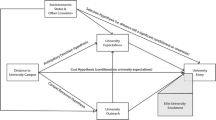Abstract
One issue that has received little attention is how students factor distance from home into their decisions about college. In this study, we used data from the Education Longitudinal Survey of 2002 (ELS:02) to examine the distances between a student’s home and the colleges to which they applied, and how far from home they enrolled. We focused on how demand- and supply-side factors were related to the distances applied and enrolled. We tested the sensitivity of our findings to alternative ways of measuring the supply of postsecondary education within commuting distance, and identified factors associated with differences between a student’s application and enrollment distances. Finally, we used quantile regression analysis to determine if the associations between demand- and supply-side factors and distances applied and enrolled varied along the distance distributions.


Similar content being viewed by others
Data availability
The data used in this study can be obtained through a license with the National Center for Education Statistics.
Notes
Although it is a more recent survey, the High School Longitudinal Study of 2009 (HSLS:09) was not used because it only provides information on up to three institutions to which a student applied, and does not contain the student’s ZIP code during high school.
Applications and enrollments from students from the mainland to colleges in Hawaii and Alaska were included.
All sample sizes are rounded per NCES requirements. The data used in all tables have been weighted using the ELS variable F2F1WT to account for the complex sampling design used in the survey.
The student ZIP code was collected in the 2004 ELS first Follow-up Survey. We also used this ZIP code to infer the students’ county, which is in turn aggregated up to the commuting zone level. The ZIP codes for colleges were gathered from the 2004 IPEDS file. If no college ZIP code existed in IPEDS 2004, we used the ZIP codes as reported in IPEDS surveys for other years.
The straight-line distances were derived using Stata’s Geodist command. We acknowledge that there are other ways to measure distance, including the commuting distance between two points in miles and time. The computation of these alternate measures would require connecting the computer with the restricted-use data to the internet, which is prohibited by the licensing agreement with IES.
The clusters of counties for each commuting zone were created by the USDA Economic Research Service using “journey to work” data from the 2000 US Census.
Median family income was generated as a weighted average of the counties that comprise each commuting zone (i.e., median household income times the number of households in county). The unemployment rate per commuting zone was an average for the years 2004–2006.
We also estimated all of the models using standard errors clustered at the state level and found no appreciable differences in the significance levels for the variables.
While ordinary least squares selects coefficients that minimize the sum of squared deviations, quantile regression selects coefficients that minimize the sum of weighted absolute deviations. The weights in quantile regression analysis allow separate parameters to be estimated for different percentiles of the distribution. More details on quantile regression analysis can be found in Koenker and Hallock (2001).
Due to space limitations, the results for the state variables in the models that follow are not shown but are available upon request.
The results were fairly robust when we used either the median or maximum distances applied.
References
Alm, J., & Winters, J. (2009). Distance and intrastate college student migration. Economics of Education Review, 28, 728–738.
Baryla, E., & Dotterweich, D. (2001). Student migration: Do significant factors vary by region? Education Economics, 9, 269–280.
Becker, W., & Toutkoushian, R. (2013). On the meaning of markets in higher education. In M. Paulsen (Ed.), Higher education: Handbook of theory and research (Vol. XXVIII, pp. 323–376). Springer.
Bourdieu, P. (1973). Cultural reproduction and social reproduction. In R. Brown (Ed.), Knowledge, education, and cultural change. Routledge.
Bourdieu, P. (1977). Outline of a theory of practice. Cambridge University Press.
Bourdieu, P. (1990). The logic of practice. Stanford University Press.
Byun, S., Irvin, M., & Meece, J. (2015). Rural–nonrural differences in college attendance patterns. Peabody Journal of Education, 90, 263–279.
Coleman, J. (1988). Social capital in the creation of human capital. American Journal of Sociology, 94, 95–120.
Cooke, T., & Boyle, P. (2011). The migration of high school graduates to college. Educational Evaluation and Policy Analysis, 33, 202–213.
Dache-Gerbino, A. (2018). College desert and oasis: A critical geographic analysis of local college access. Journal of Diversity in Higher Education, 11, 97–116.
De Graaf, N., De Graaf, P., & Kraaykamp, G. (2000). Parental cultural capital and educational attainment in the Netherlands: A refinement of the cultural capital perspective. Sociology of Education, 73, 92–111.
Denzler, S., & Wolter, S. (2011). Too far to go? Does distance determine study choices? IZA Discussion Paper No. 571. The Institute for the Study of Labor.
DesJardins, S., Ahlburg, D., & McCall, B. (2006). An integrated model of application, admission, enrollment, and financial aid. Journal of Higher Education, 77, 381–429.
Dill, D. (1997). Higher education markets and public policy. Higher Education Policy, 10, 167–185.
Dillon, E., & Smith, J. (2017). Determinants of the match between student ability and college quality. Journal of Labor Economics, 35, 45–66.
Do, C. (2004). The effects of local colleges on the quality of college attended. Economics of Education Review, 23, 249–257.
Eagan, K., Stolzenberg, E., Ramirez, J., Aragon, M., Suchard, M., & Rios-Aguilar, C. (2016). The American freshman: Fifty-year trends 1966–2015. Higher Education Research Institute.
Evans, M., Kelley, J., Sikora, J., & Treiman, D. J. (2010). Family scholarly culture and educational success: Books and schooling in 27 nations. Research in Social Stratification and Mobility, 28, 171–197.
Frenette, M. (2004). Access to college and university: Does distance to school matter? Canadian Public Policy, 30, 427–443.
Frenette, M. (2006). Too far to go on? Distance to school and university participation. Education Economics, 14, 31–58.
Garza, A., & Fullerton, A. (2018). Staying close or going away: How distance to college impacts the educational attainment and academic performance of first-generation college students. Sociological Perspectives, 61, 164–185.
Ghatak, S., Levine, P., & Price, S. (1996). Migration theories and evidence: An assessment. Journal of Economic Surveys, 10, 159–198.
Gibbons, S., & Vignoles, A. (2012). Geography, choice and participation in higher education in England. Regional Science and Urban Economics, 42, 98–113.
González Canché, M. (2018). Nearby college enrollment and geographical skills mismatch: (Re)conceptualizing student out-migration in the American higher education system. The Journal of Higher Education, 89, 892–934.
Greenwood, M. (1975). Research on internal migration in the United States: A survey. Journal of Economic Literature, 13, 397–433.
Griffith, A., & Rothstein, D. (2009). Can’t get there from here: The decision to apply to a selective college. Economics of Education Review, 28, 620–628.
Guillory, J. (2023). Cultural capital: The problem of literary canon formation. University of Chicago Press.
Han, P. (2014). A literature review on college choice and marketing strategies for recruitment. Family and Consumer Sciences Research Journal, 43, 120–130.
Hill, L., Bregman, A., & Andrade, F. (2015). Social capital for college: Network composition and access to selective institutions among urban high school students. Urban Education, 50, 316–345.
Hillman, N. (2016). Geography of college opportunity: The case of education deserts. American Educational Research Journal, 53, 987–1021.
Hirschl, N., & Smith, C. (2020). Well-placed: The geography of opportunity and high school effects on college attendance. Research in Higher Education, 61, 567–587.
Holloman, D., & Nolen, A. (2008). Recruiting place bound students: The influence of location on the college choice of high-school seniors. Metropolitan Universities, 19, 41–53.
Hossler, D., & Gallagher, K. (1987). Studying student college choice: A three-phase model and the implications for policymakers. College and University, 62, 207–221.
Hossler, D., Schmit, J., & Vesper, N. (1999). Going to college: How social, economic, and educational factors influence the decisions students make. The Johns Hopkins University Press.
Ishitani, T. (2011). The determinants of out-migration among in-state college students in the United States. Research in Higher Education, 52, 107–122.
Jaeger, M., & Breen, R. (2016). A dynamic model of cultural reproduction. American Journal of Sociology, 121, 1079–1115.
Kim, D. (2004). The effect of financial aid on students’ college choice: Differences by racial groups. Research in Higher Education, 45, 43–70.
Klasik, D., Blagg, K., & Pekor, Z. (2018). Out of the education desert: How limited local college options are associated with inequity in postsecondary opportunities. Social Sciences, 7, 165–190.
Koenker, R., & Hallock, K. (2001). Quantile regression. Journal of Economic Perspectives, 15, 143–156.
Leppel, K. (1993). Logit estimation of a gravity model of the college enrollment decision. Research in Higher Education, 34, 387–398.
Lillis, M., & Tian, R. (2008). The impact of cost on college choice: Beyond the means of the economically disadvantaged. Journal of College Admission, 200, 4–14.
Marginson, S. (2019). Limitations of human capital theory. Studies in Higher Education, 44, 287–301.
Mattern, K., & Wyatt, J. (2009). Student choice of college: How far do students go for an education? Journal of College Admission, 203, 18–29.
McHugh, R., & Morgan, J. (1984). The determinants of interstate student migration: A place-to-place analysis. Economics of Education Review, 3, 269–278.
Mishra, S. (2020). Social networks, social capital, social support and academic success in higher education: A systematic review with a special focus on ‘underrepresented’ students. Educational Research Review, 29, 1–24.
Mixon, F. (1992). Factors affecting college student migration across states. International Journal of Manpower, 13, 25–32.
Mixon, F., & Hsing, Y. (1994). The determinants of out-of-state enrollment in higher education: A tobit analysis. Economics of Education Review, 13, 329–335.
Mortenson, T. (1996). Freshmen enrolling in college farther from home, but who can afford to go so far away? Postsecondary Education Opportunity, 50, 8–13.
Mortenson, T. (1998). Interstate migration of college undergraduates. Postsecondary Education Opportunity, 70, 1–12.
Morton, T., Ramirez, N., Meece, J., Demetriou, C., & Panter, A. (2018). Perceived barriers, anxieties, and fears in prospective college students from rural high schools. High School Journal, 101, 155–176.
Niu, S. (2015). Leaving home state for college: Differences by race/ethnicity and parental education. Research in Higher Education, 56, 325–359.
Perna, L. (2006). Studying college access and choice: A proposed conceptual model. In J. Smart (Ed.), Higher education: Handbook of theory and research. (Vol. XXI). Kluwer Academic Publishers.
Pryor, J., Hurtado, S., Saenz, V., Lindholm, J., Korn, W., & Mahoney, K. (2006). The American freshman: National norms for Fall 2005. Higher Education Research Institute. Retrieved July 9, 2013 from http://heri.ucla.edu/PDFs/ResearchBrief05.PDF
Sandefur, G., Meier, A., & Campbell, M. (2006). Family resources, social capital, and college attendance. Social Science Research, 35, 525–553.
Spiess, C., & Wrohlich, K. (2010). Does distance determine who attends a university in Germany? Economics of Education Review, 29, 470–479.
Stephenson, A., Heckert, A., & Yerger, D. (2016). College choice and the university brand: Exploring the consumer decision framework. Higher Education, 71, 489–503.
Tinto, V. (1973). College proximity and rates of college attendance. American Educational Research Journal, 10, 277–293.
Toutkoushian, R. (2001a). Do parental income and educational attainment affect the initial choices of New Hampshire’s college-bound students? Economics of Education Review, 20, 245–262.
Toutkoushian, R. (2001b). Changes in the demand for public land-grant universities: The use of panel datasets. Research in Higher Education, 42, 679–707.
Toutkoushian, R., & Hillman, N. (2012). The impact of state appropriations and grants on access to higher education and state outmigration. The Review of Higher Education, 36, 51–90.
Toutkoushian, R., & Paulsen, M. (2016). Economics of higher education: Background, concepts, and applications. Springer.
Tramonte, L., & Willms, J. D. (2010). Cultural capital and its effects on education outcomes. Economics of Education Review, 29, 200–213.
Tuckman, H. (1970). Determinants of college student migration. Southern Economic Journal, 37, 184–189.
Turley, R. (2009). College proximity: Mapping access to opportunity. Sociology of Education, 82, 126–146.
Turner, S. (2017). Education markets: Forward-looking policy options. Hutchins Center Working Paper #27. Brookings.
Wells, R., Manly, C., Kommers, S., & Kimball, E. (2019). Narrowed gaps and persistent challenges: Examining rural–nonrural disparities in postsecondary outcomes over time. American Journal of Education, 126, 1–31.
Zhang, L., & Ness, E. (2010). Does state merit-based aid STEM brain drain? Educational Evaluation and Policy Analysis, 32, 143–165.
Acknowledgements
We are grateful to the Spencer Foundation for financial support for this project (grant #201900227). An earlier version of this paper was presented at the annual meeting of the Southern Economic Association. We would like to thank participants at the Southern Economic Association conference and Steve DesJardins for comments on an earlier draft of this study.
Author information
Authors and Affiliations
Corresponding author
Ethics declarations
Conflict of interest
I have no known conflict of interest to disclose.
Additional information
Publisher's Note
Springer Nature remains neutral with regard to jurisdictional claims in published maps and institutional affiliations.
Rights and permissions
Springer Nature or its licensor (e.g. a society or other partner) holds exclusive rights to this article under a publishing agreement with the author(s) or other rightsholder(s); author self-archiving of the accepted manuscript version of this article is solely governed by the terms of such publishing agreement and applicable law.
About this article
Cite this article
Toutkoushian, R.K., Mayfield, S. & Jelks, S.M.R. Destiny Unbound: A Look at How Far from Home Students Go to College. Res High Educ (2024). https://doi.org/10.1007/s11162-024-09790-x
Received:
Accepted:
Published:
DOI: https://doi.org/10.1007/s11162-024-09790-x




